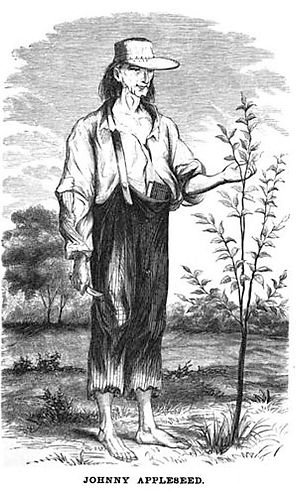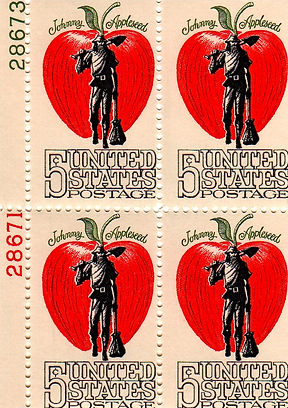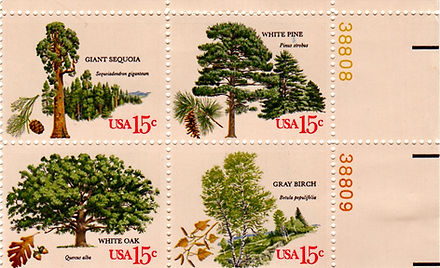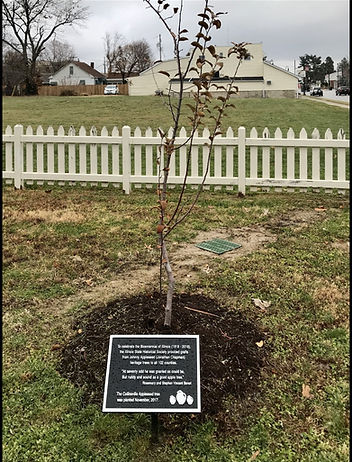
Located at the Corner of Combs
and West Main Street
Collinsville, IL 62234
Our Johnny Appleseed Tree ~
On Tuesday, October 16, 2017 Trisha Haislar, Sarah Wilkerson, Bill Iseminger, and Lavadna Hines planted the Johnny Appleseed Tree. This is a special tree, indeed. It was donated to the D.D. Collins House by Mary Sue Schusky.


This special Johnny Appleseed tree is planted with love and care.
Photos by Lavadna Hines
Family tree of our apple tree ~
This tree commemorates the work of John Chapman, the fellow we all know as Johnny Appleseed as well as the bicentennial of Illinois statehood on December 3, 2018. The Illinois State Historical Society depended on the expertise of Guy Sternberg, director of Starhill Forest Arboretum, for assistance in selecting a rare and special tree. Illinois was one of the states Johnny Appleseed left his mark by planting apple nurseries using seeds from a cider mill near his original home in Pennsylvania in the early 19th century.
The "Johnny Appleseed" variety of apple ripens in September. It is a baking applesauce variety of apple. The Algeo Farm in Nova, Ohio is home to the last known surviving tree that Johnny planted. Mr. Sternberg decided that a graft of the Algeo tree would be planted in every state where Johnny was known to plants the trees. The official Illinois tree was planted at Starhill Forest Arboretum as well as the Lincoln Memorial Garden in Springfield.
Our thanks to The Illinois State Historical Society for providing the information on our Johnny Appleseed Tree.
A number of people gathered at the historic D.D. Collins House on Thursday, November 9, 2017 for the dedication of the Johnny Appleseed Tree.
Johnny Appleseed - American Folk Hero - Legend and Fact
Written by Mary Sue Schusky
I enjoyed poetry in school and have always remembered lines from a poem by American poets, Rosemary and Stephen Benet. In October the Collinsville Garden Club planted a specially grafted Johnny Appleseed apple tree at the Collins House to observe Illinois Bicentennial year in 2018. As part of the Illinois State Historical Society’s outreach to the state, these heritage apple trees were available to every county in the state.
Of Johnny Chapman, two things are known
That he loved apples
And he walked alone.
At seventy odd he was gnarled as could be.
But ruddy and sound as a good apple tree.

Image from Howe's Historical Collection
Jonathan Chapman, who was born in 1774 in Massachusetts, spent most of his life as an itinerant salesman selling apple seeds and seedlings for less than ten cents a piece. He walked across large parts of Pennsylvania, Ohio, Indiana and Illinois introducing apple and pear trees to settlers. Much of the time he walked barefoot, sometimes with a tin hat on his head that he used to pick berries. He often stayed with farmers and friends along the way and bartered goods or seedlings in exchange for lodging. If people were low on funds, Chapman gave them gifts of cash as well as his seedlings.
In spite of Chapman’s spartan life and his generosity, he became a successful businessman. When he died in 1845 in Ft. Wayne, Indiana, he owned 1,200 acres of land but had never owned a permanent home.
FACTS ABOUT THE MAN AND HIS STORY

The stamps were provided by Mary Sue Schusky and are from the Irving Dilliard Collection.
A few more lines from the Benets’ poem:
For fifty years over harvest and dew
He planted his apples
Where no apples grew,
The winds of the prairie might
Blow through his rags,
But he carried his seeds in
The best deerskin bags.

Image from the Illinois Heritage Magazine, a publication of The Illinois State Historical Society.
It’s not known what motivated Chapman to spend forty-six years planting fruit trees across the Midwest. He know that planting apple and pear trees helped farmers stake claims to new land. Creating orchards was a visible sign for the government that the settlers were committed to their land. An average apple tree took almost ten years to bear fruit.
Chapman had learned his craft as a young man while picking seeds and working at cider mills in the East. He also knew there was still no way to ensure that local drinking water was safe. People drank cider, usually hard cider, and apples were the basic ingredient need to make cider. Unlike our apples today, early apples were small and bitter and often referred to as “spitters.”
The last known surviving apple tree planted by Chapman was at Algeo Farm in Nova, Ohio. While some claim it as a variety called Rambo, most arborists use “Johnny Appleseed,” a variety that is similar to the Albermarle Pippin, another heritage apple made famous by none other than Thomas Jefferson who grew Pippins in his orchard at Monticello. The Illinois State Historical Society cooperated with a program of the American Forests Association called “Famous and Historic Trees” to obtain grafts from the original Algeo tree and sell them to all 102 counties in the state. To help celebrate almost 200 years of life in Collinsville, the City and the Collins House were happy to receive an Appleseed heritage tree from a longtime Collinsville resident.


Trees of Illinois and Illinois state 150th anniversary - blocks of stamps were provided by Mary Sue Schusky and are from the Irving Dilliard Collection.
A FEW FACTS ABOUT TODAY’S APPLES
Of the 2,500 varieties of apples grown in the United States, one hundred varieties are sold commercially for our eating, cooking and snacking. One of the most successful newer apples, the Honeycrisp, is now over fifty years old. Honeycrisp. The “designer” Honeycrisp was developed at the University of Minnesota through cross-breeding and is now the most planted variety in Washington State, the country’s biggest apple producer. Apples are sodium, fat and cholesterol free and a great source of fiber, thus an apple a day can help keep the doctor away. And today young and old alike live everyday with a totally new, man made creation, the Apple computer!
So let’s read the last lines of the Benets’ poem about one of America’s early naturalists and horticulturists:
Consider, consider
Think well upon
The marvelous story
Of Appleseed John.
Photo of tree and plaque taken by Carolyn Welch.
Close-up of plaque taken by Carolyn Welch.
To celebrate the Bicentennial of Illinois (1818 - 2018), the Illinois State Historical Society provided grafts from Johnny Appleseed (Jonathan Chapman) heritage trees to all 102 counties.

"At seventy odd he was
gnarled as could be,
But ruddy and sound as
a good apple tree."
~ Rosemary and Stephen Benet

Close-up of plaque taken by Carolyn Welch.
Arrangements for this beautiful signage were made by Mary Sue Schusky, who also arranged for the tree. There will be a re-dedication of the Johnny Appleseed tree later this year.


Mary Sue poses with the tree in April of 2023.
.jpg)
.jpg)
Phone: Call Lavadna at 618.420.0288
Mail: c/o 104 Irene Dr., Collinsville, IL 62234
Email: artloft@charter.net
